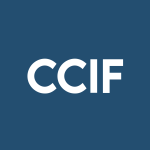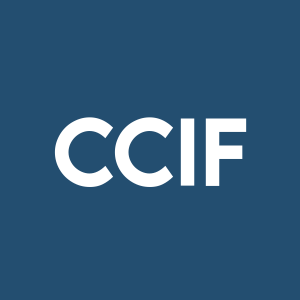Welcome to our dedicated page for Carlyle Credit Income Ord SEC filings (Ticker: CCIF), a comprehensive resource for investors and traders seeking official regulatory documents including 10-K annual reports, 10-Q quarterly earnings, 8-K material events, and insider trading forms.
Parsing Carlyle Credit Income Ord Fund’s CLO disclosures is challenging: cash-flow waterfalls, asset-coverage ratios, and convertible preferred triggers are scattered across hundreds of pages. If you have ever asked, “Carlyle Credit Income Ord Fund SEC filings explained simply” or “How do I track Carlyle Credit Income Ord Fund insider trading Form 4 transactions?”, this page is built for you.
Stock Titan’s AI reads every document the moment it hits EDGAR—10-K annual reports, 10-Q quarterly earnings, N-CSR shareholder reports, 8-K material event notices, and Form 4 insider trades—then translates the legal and structured-credit language into clear takeaways. Need the latest Carlyle Credit Income Ord Fund quarterly earnings report 10-Q filing or a real-time alert for a director’s Form 4 sale? Our engine tags each topic, highlights how changes in CLO equity cash flows affect distributions, and pinpoints leverage movements line by line.
Here’s what you can do right now:
- Monitor Carlyle Credit Income Ord Fund executive stock transactions Form 4 the instant they post.
- Compare distribution coverage trends across successive N-CSR filings with Carlyle Credit Income Ord Fund earnings report filing analysis.
- Receive plain-English digests of Carlyle Credit Income Ord Fund 8-K material events explained, from dividend declarations to CLO restructuring news.
Karpus Management, Inc., doing business as Karpus Investment Management, reported a significant position in the preferred shares of Carlyle Credit Income Fund. Karpus disclosed beneficial ownership of 265,100 preferred shares, representing 22.09% of this class.
Karpus has sole power to vote and dispose of all 265,100 shares and reports no shared voting or dispositive power. The shares are held in accounts managed by Karpus as a registered investment adviser, and are reported as being acquired and held in the ordinary course of business, without the purpose or effect of changing or influencing control of the fund.
Carlyle Credit Income Fund reported that it has released its fourth quarter 2025 financial results. On November 18, 2025, the fund announced that a summary earnings press release and a detailed earnings presentation were made available to describe its performance for the quarter. These materials, dated September 30, 2025, are provided as exhibits to the report and are furnished rather than filed, meaning they are supplied for investors’ information but are not automatically incorporated into other regulatory documents.
Carlyle Credit Income Fund$5.93 per common share as of October 31, 2025. NAV reflects the value of the fund’s assets minus liabilities on a per-share basis and is a key snapshot of portfolio value.
This update was disclosed under “Other Events,” indicating a routine valuation update rather than a transactional change.
Eagle Point Credit Management LLC filed Amendment No. 1 to Schedule 13G reporting a passive stake in Carlyle Credit Income Fund preferred shares. The firm reports beneficial ownership of 330,015 preferred shares, representing 15.69% of the class, with sole voting and dispositive power over 330,015 shares. The event date is 09/30/2025.
The filer is classified as an investment adviser and certified the securities were not acquired to change or influence control. This amendment updates ownership information without indicating any control-related intent.
Carlyle Credit Income Fund announced a listing change for one of its securities. The New York Stock Exchange filed a Form 25 to remove the Fund’s 8.75% Series A Preferred Shares due 2028 from listing and/or registration under Section 12(b) of the Securities Exchange Act of 1934.
The filing states the Exchange has complied with its rules to strike the class from listing, and it notes the issuer’s compliance with Exchange rules and applicable requirements for a voluntary withdrawal.
Carlyle Credit Income Fund entered a private placement to issue approximately 17,500 shares of its 7.25% Series E Convertible Preferred Shares due 2030 at $930 per share, generating ~$16.275 million in net proceeds before expenses. The Fund plans to use the proceeds to redeem its Series A Preferred Shares and for working capital.
The shares carry a $1,000 liquidation preference and pay quarterly dividends at 7.25% of liquidation preference ($72.50 per share annually), with payments every January 31, April 30, July 31 and October 31, starting January 31, 2026. The Fund may optionally redeem them on or after May 1, 2026, and must redeem them on October 30, 2030.
Holders may convert after six months into common shares at a price equal to the greater of market price or most recently reported NAV per share at exercise. Protections include asset coverage redemption triggers, a change‑of‑control repurchase right at 100% of liquidation preference plus accrued, and a 1.00% coupon step‑up if ratings fall below investment grade. The shares are not listed and transfers require the Fund’s consent.
Carlyle Credit Income Fund (CCIF) reports estimated total net asset value of $132.89 million or $6.27 per share, while the closing share price was $5.74, trading at an 8.45% discount to NAV and a total market capitalization of $121.68 million. The fund targets monthly common dividends and shows a current dividend rate of 21.95%.
The portfolio is concentrated in senior secured loans, with 96.71% exposure to first-lien loans and aggregate underlying loan balances of $24.43 billion across 2,126 loans and 1,514 obligors. The weighted average market price of loan collateral is 97.45 and the fund’s last 12-month default rate on underlying loans including distressed exchanges is 1.29%, versus a loan market default rate of 3.37%. Top industry exposures include High Tech (12.39%) and Healthcare & Pharmaceuticals (11.38%).
Carlyle Credit Income Fund (CCIF) reported that on August 19, 2025 it issued a summary press release and a detailed earnings presentation announcing its third quarter 2025 financial results. The filing states that those materials are attached as Exhibit 99.1 and Exhibit 99.2 and are being furnished, not filed, under the Exchange Act. No financial figures or operational details are included in this 8-K; the submission only confirms availability of the press release and presentation as exhibits.
Carlyle Credit Income Fund (CCIF) is a closed-end fund investing primarily in CLO junior debt and equity and first-lien loans. As of July 2025 the fund's estimated net assets were $138.19 million, NAV per share $6.52 and market cap $119.35 million, with shares trading at a 13.65% discount to NAV. The fund reports a high current dividend rate of 22.38% paid monthly but cautions distributions may include return of capital. Portfolio exposure is concentrated in senior secured loans (96.56%) across ~2,056 loans to 1,502 obligors, with a weighted average loan price of 97.58 and a last 12-month default rate of 1.33%, below the loan market default rate of 3.86%.


